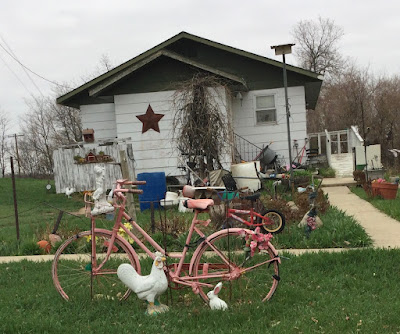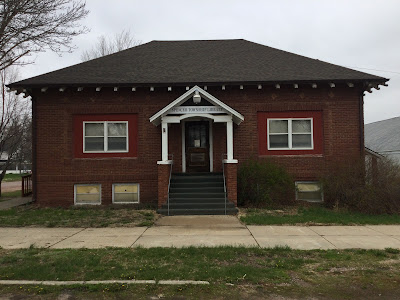I had my first pancakes, or rather pancake, of the trip thanks to the Carnegie in Spencer, my last In Nebraska ten miles before South Dakota, being closed. The library in this town of 455 was only open three days a week and for just four hours at a time. Remarkably, the town had a cafe where I could get out of the cold, rest my legs, charge my iPad, get some food into me and make use of it’s WiFi, although the waitress wasn’t sure if it was working.
The menu had a plate-sized pancake for two dollars. I ordered one, and would have had another if it hadn’t filled me, but it did indeed. There were couples at three other tables and two other sets of patrons came in while I was there. A somewhat crabby, white-haired lady got up from one of the tables and came over to tell me she had passed me a few miles out of town and nearly didn’t see me in the heavy overcast. “You need to wear a reflective vest,” she said in a not very friendly manner. I told her I thought the reflective patches on my panniers would have caught her eye, but appreciated her concern and that I had a flashing red light I could use. “That would help, but you need one of those reflective vests,” she snapped.
Her testy personality was quite a contrast to the otherwise most amiable disposition of everyone else I’ve encountered. I haven’t been taken for an indigent, as is often the case on the other side of the Mississippi, but someone with an adventuristic spirit that these westerners can relate to. No one regards me warily, but are happy to have an interaction with me. The ubiquity of camping in town parks is a testament to their sense of welcome to those carrying on the frontier spirit imbued in these folk. When I asked a librarian if there was camping in her town’s park, she responded with “Oh, sure,” a polite version of “that’s a dumb question.”
It was another cold day, my fifth in a row where the temperature didn’t get out of the forties. If I abided by the axiom that some cyclists follow of not going out on one’s bike unless the temperature was warmer than their age, I wouldn’t have been doing much riding in these past two weeks. Only twice has the temperature topped seventy, though the forecast promises some such days right around the corner. It has been cold enough several mornings, just above freezing, that my iPad wouldn’t turn on, preventing me from recording my miles for my Strava account. I lost eighteen miles yesterday, recording just sixty-two for the day. I’m over five thousand for the year, so the lost miles aren’t putting much of a dent in my totals, but they’re adding up, easily over a hundred for the year.
Small as the town was it had a decent-sized grocery store, the first I had come upon in days. It has only been Dollar Stores. The population density is so small Walmart hasn’t moved in. I do hear people say they’ll drive fifty miles to the nearest.







No comments:
Post a Comment